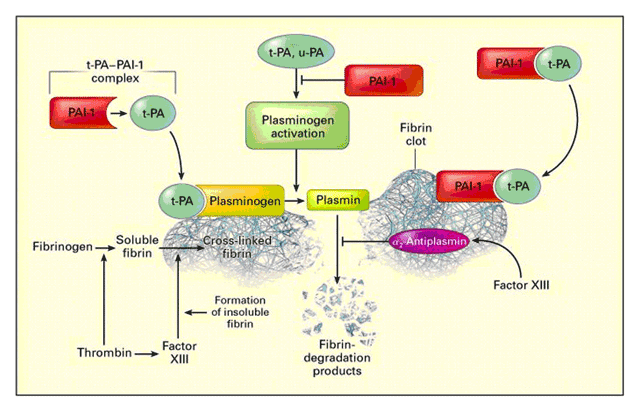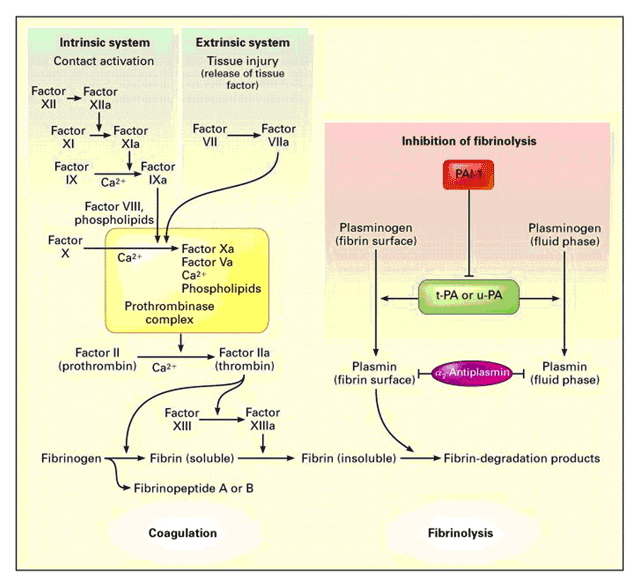 |
James L. Holly, M.D. |
|
 |
|
|
|
|
|
|
|
|
| James L. Holly,M.D. |
| January 11, 2007 |
| Your Life Your Health - The Examiner |
|
In Part IV of our series on the Cardiometabolic Risk Syndrome (CRS), we discussed abnormal function in the lining of the arteries which is called “endothelial dysfunction.” (see The Examiner, January 4, 2007) The increased risk of blood clotting and atherosclerosis in the presence of endothelial dysfunction is one of the greatest dangers of the cardiometabolic risk syndrome. Yet, the cardiometabolic risk syndrome is also associated with another abnormality which contributes to heart disease, strokes and heart attacks. It is called “fibrinolytic dysfunction.”
Fibrinolysis is the function of the body which helps regulate blood clotting. When a clot begins to be formed a series of steps takes place which prevents the completion of the forming of the clot. This protective function prevents heart attacks, strokes and other cardiovascular incidents. Excessive blood clotting - thrombosis - is caused by a decrease in the fibrinolytic activity of elements of the blood and this is called “fibrinolytic dysfunction.”
As we are learning, the cardiometabolic risk syndrome is associated with many abnormalities and one of the most common is an increased tendency for the blood to form clots. The flow of blood to the organs in the body is critical to the survival of the individual and to the proper function of the body. If the blood is sluggish or tends to clot too fast, the body will suffer; if the blood is too “thin” or does not clot, the body will suffer. The balance between blood clotting and blood not clotting is one of the most critical balancing acts in the human body. The mechanisms which control those functions are complex.
The following diagram shows the complex relationships which control the balance between blood clotting - which is called “thrombus” - and blood not clotting - which is called “fibrinolysis.” The reality is that too much blood clotting is bad but not enough clotting is also bad. On the other hand, too much dissolving of blood clots (fibrinolysis) is bad and too little dissolving of blood clots is bad.
Fibrinolytic Pathway: Activation and Inhibition

The following diagram shows the interaction between the clotting action (coagulation) and the anti-clotting action (fibrinolysis) of the blood.
Coagulation and Fibrinolytic Pathways

It is not necessary for you to learn or even to understand all of these steps. What is necessary is for you to have a mental picture of the complex processes which continually take place in your body to make certain that your blood can flow to provide oxygen and nutrients to your cells and to make certain that your blood flow can be stopped if you are injured.
The Calcium/Magnesium Ratio
It is important to remember that calcium promotes blood clotting while magnesium promotes the lysis (breaking up) of blood clots. The balancing act between clotting and not clotting is partially maintained by a balance between calcium and magnesium in the blood.
An important number to know about your health is your calcium/magnesium ratio. When this ratio is below 4 the balance between the forming and lysis of blood clots in your body from calcium which promotes clotting and magnesium which promotes the breaking up of clots is appropriate. When this ratio is above 4 there is an imbalance, which may promote increased blood clotting.
Because calcium is important to many bodily functions, the control of this ratio is achieved by increasing the magnesium in your diet not by decreasing the calcium. However, there are diseases which cause excessive levels of calcium in the blood which should be treated by decreasing the calcium.
In that the cardiometabolic risk syndrome is associated with a “bad” diet, it will not be surprising to learn that the principle sources of magnesium come from a healthy diet. Green vegetables such as spinach are good sources of magnesium because the center of the chlorophyll molecule (which gives green vegetables their color) contains magnesium. Some legumes (beans and peas), nuts and seeds, and whole, unrefined grains are also good sources of magnesium. Refined grains are generally low in magnesium. When white flour is refined and processed, the magnesium-rich germ and bran are removed. Bread made from whole grain wheat flour provides more magnesium than bread made from white refined flour. Tap water can be a source of magnesium, but the amount varies according to the water supply. Water that naturally contains more minerals is described as "hard". "Hard" water contains more magnesium than "soft" water.
Your doctor can easily determine your calcium/magnesium ratio and can recommend dietary approaches to its management.
Fibrinolytic Dysfunction
The human body must maintain a delicate balance between blood clotting and blood not clotting. Thrombosis (clotting) is the pathological results of excessive blood clotting. Hemorrhaging (bleeding) is the pathological result of excessive fibrinolysis. The abnormalities associated with the cardiometabolic risk syndrome, particularly insulin resistance and hyperinsulinism, (see The Examiner December 7, 2006, The Cardiometabolic Risk Syndrome Part II - Insulin Resistance) enhance the blood’s tendency for acute thrombosis (clotting) through interfering with fibrinolysis (breaking up of clots). Thrombotic (clotting) risk, which is higher in diabetes type 2, impaired fasting glucose and impaired glucose tolerance (see The Examiner December 14, 2006, The Cardiometabolic Risk Syndrome Part III - Pre-Diabetes: Impaired Fasting Glucose & Impaired Glucose Tolerance) may be mediated more by impaired fibrinolysis than by hypercoagulability (increased clotting).
People with the cardiometabolic risk syndrome have increased atherosclerosis and their fibrinolytic function is abnormal. Specifically, plasminogen activator inhibitor-1 (PAI-1) is increased among type 2 diabetic patients and predicts myocardial infarction and stroke. Also, elevated endogenous tissue-type plasminogen activator (tPA) predicts mortality and myocardial infarction, and is elevated in response to endogenous fibrinolytic inhibitors such as PAI-1. It is likely, therefore, that high plasma concentrations of PAI-1 and tPA reflect a state of fibrinolytic dysfunction.
Fibrinolytic dysfunction increases the tendency to develop arterial thrombosis, which in turn may increase cardiovascular disease in people with the cardiometabolic risk syndrome. This hypothesis is supported by the recent observations that diabetes and abdominal obesity are risk predictors of both venous thrombosis and occlusive arterial disease. Although prior studies have documented that markers of fibrinolysis are abnormal in people with the cardiometabolic risk syndrome, it remains unclear whether these abnormalities reflect fibrinolytic dysfunction or are merely a response to vascular injury or plaque turnover. Functional tests of fibrinolysis are available; however, because of the complexity involved in performing them, they have not been performed on a large scale.
Fibrinolysis is suppressed by increased plasma levels of:
- Plasminogen-activator inhibitor type 1 (PAI-1) -- a protein which regulates the balance between clotting and fibrinolysis
- Factor VII - a factor needed for the normal clotting of blood
- Fibrinogen - a normal occurring blood protein
- von Willebrand factor - an abnormal clotting factor found in a disease state
High concentrations of tissue plasminogen activator (t-PA) and d-dimer (a measure of fibrinolysis) increase the risk of myocardial infarction. It is possible to test for these conditions clinically. While these tests are not widely used in ambulatory clinical medicine, those with the cardiometabolic risk syndrome can appreciate the hazard they have for thrombosis by having their PAI-1, Fibrinogen and D-dimer checked. This is done through blood tests. Unfortunately, most insurance companies will not pay for these tests currently so the individual would have to bear that expense.
Plasminogen Activator Inhibitor 1
Decrease in fibrinolysis due to high plasma PAI-1 results in deposition of fibrin and formation of a thrombus. There is an association between the presence of coronary artery disease and low plasma fibrinolytic activity due to increased plasma PAI-1 levels. PAI-1 levels are lower in the day than at night -- the higher incidence of MIs in the early morning hours could be due to higher plasma PAI-1 concentrations and therefore lower fibrinolytic activity at night.
PAI-1 is directly stimulated by:
- Insulin - the cardiometabolic risk syndrome with increased insulin increases PAI-1 therefore increasing clot formation
- Proinsulin-like molecules - several proteins in the blood which act like insulin which also promote clotting.
- Glucose - in conditions which increase blood sugar, i.e., pre-diabetes (impaired fasting glucose or impaired glucose tolerance) or diabetes, PAI-1 is increased in the blood.
- VLDL triglycerides - this is one of the abnormal kinds of cholesterol particles which are found in the cardiometabolic risk syndrome.
Improving blood clotting abnormalities in the cardiometabolic Risk Syndrome
- Calcium/Magnesium Ratio - increase the blood magnesium by dietary management an/or supplement of diet with magnesium
- Plasminogen activator Inhibitor 1
- Weight loss
- Control of hyperglycemia
- Lowering insulin resistance
- Estrogen-replacement therapy in postmenopausal women
- Suppressing renin-angiotensin system - this is done with medications called ACE Inhibitors such as Altace, Captopril, etc.
- Fibrinogen
- Stop smoking - this is imperative
- Weight reduction
- Exercise
- Low glycemic diet
- Aspirin
- Omega-3 Fish Oil
- Controlling glucose with metformin, actos, etc.
- Endothelia Dysfunction
- Magnesium supplement
- Statins to lower cholesterol
- ACE Inhibitor
- Control insulin levels
- Folic Acid supplement
- Decrease PAI-1
- Decrease Fibrinogen
- Decrease hsCRp
- Decrease homocysteine
Next week, we will continue with our discussion of the cardiometabolic risk syndrome. If you are overweight, have high cholesterol, have insulin resistance, have high blood pressure or other elements of the cardiometabolic risk syndrome you should speak to your health care provider about how to improve your health. Remember, it is your life and it is your health.
|
|
|
|
|
|
|
|
|
|
|